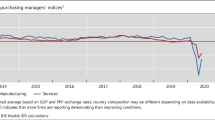Abstract
The notion of contagion has changed the wayscientists perceive financial crises,causing heated debate on the politicaleconomy of crisis intervention. Based on aformal model that shows how a financialcrisis can escalate and spread contagiously,this article analyzes game-theoreticallyhow a financial market crisis can becontained through intervention. The centralfocus is the role that internationalorganizations play in overcoming thecollective action problem of jointintervention. It is argued that the IMFsupport programs were helpful, and probablynecessary in a class of cases we analyzemore carefully, in surpassing the thresholdlevel of collective action.
Similar content being viewed by others
References
Anderson, R.M. and May, R.M. (1991). Infectious diseases of humans: Dynamics and control. Oxford: Oxford Science Publishers. Baig, T. and Goldfayn, I. (1998). Financial market contagion in the Asian crisis. IMFWorking Paper 98/155.
Bayley, N.T.J. (1975). The mathematical theories of infectious diseases and its applications. London: Griffin.
Burton, J. and Tedd, G. (1997). Japan aid for Seoul 'to come after IMF deal'. Financial Times 21 November 1997.
Calomiris, C.W. (1998). The IMF's imprudent role as lender of last resort. Cato Journal 17: 275–294.
Chote, R. (1997). Thai efforts on economy 'satisfy IMF'. Financial Times 19 September 1997.
Choueiri, N. (1999). A model of contagious currency crises with applications to Argentina. IMF Working Paper 99/29.
Corsetti, G., Pesenti, P. and Roubini, N. (1998). Paper tigers? A model of the Asian crisis. NBER Working Paper 6783.
Eichengreen B., Rose, A.K. and Wyplozs, C. (1996). Contagious currency crisis. NBER Working Paper 5681.
Eichengreen, B. (1998). Globalizing capital. A history of the International Monetary System. Princeton: Princeton University Press.
Fratzscher, M. (1998). Why are currency crises contagious? A comparison of the Latin American crisis of 1994-1995 and the Asian crisis of 1997-1998. Weltwirtschaftliches Archiv 134: 664–691.
Frauenthal, J.C. (1980). Mathematical modelling in epidemiology. Berlin: Springer-Verlag.
Grai, W. and Zheng, K. (1996). Strategic interdependence in European east-west gas trade: A hierarchical Stackelberg game approach. The Energy Journal 17: 61–84.
Granovetter, M. (1978). Threshold models of collective behavior. American Journal of Sociology 83: 1420–1443.
Granovetter, M. and Soong, R. (1986). Threshold models of interpersonal effects in consumer demand. Journal of Economic Behavior and Organization 7: 83–99.
International Monetary Fund (1999). The IMF's response to the Asian crisis. Mimeo, January 17, 1999.
International Monetary Fund (various issues). IMF Survey. Washington: IMF.
Kaminsky, G. (1998). What moves financial markets? Mimeo, Board of Governors of the Federal Reserve System.
Kaminsky, G. and Reinhart, C.M. (1999). The twin crises: The causes of banking and balanceof-payments problems. American Economic Review 89: 473–500.
Kaminsky, G. and Schmuckler, S.L. (1999). What triggers market jitters? A chronicle of the Asian crisis. Journal of International Money and Finance 18: 537–560.
Kaminsky, G., Lizondo, S. and Reinhart, C.M. (1998). Leading indicators of currency crises. IMF Staff Papers 45: 1–48.
Kermack, W.O. and McKendrick, A.G. (1927). Contributions to the mathematical theory of epidemics. Proceedings of Royal Statistics Society, A, 115: 700–721.
Kindleberger, C. (1978). Panics, manias, and crashes. A history of financial crises. New York: Basic Books.
Kingsland, S.E. (1985). Modelling nature. Chicago: The University of Chicago Press.
Krugman, P.R. (1979). A model of balance-of-payments crises. Journal of Money, Credit, and Banking 11: 311–325.
Krugman, P.R. (1998). What happened to Asia? Mimeo, MIT January 1998.
Lotka, A.J. (1924). Elements of mathematical biology. London: Dover Books.
Ludwig, D. (1974). Stochastic population theories. Berlin: Springer-Verlag.
Marozzi, J. and Baker, G. (1997). IMF is upbeat on Asian crises. Financial Times 22 July 1997.
Meltzer, A.H. (1998). Asian problems and the IMF. Cato Journal 17: 267–273.
Mishkin, F.S. (1999). Lessons from the Asian crisis. Journal of International Money and Finance 18: 709–723.
Mollison, D. (1995). Epidemic models: Their structure and relation to data. Cambridge: Cambridge University Press.
Montagnon, Peter (1997). Asia's endangered tigers. Financial Times 30 August 1997.
Obstfeld, M. (1998). The global capital market: Benefactor or menace? Journal of Economic Perspectives 12: 9–30.
OECD (various issues). International direct investment statistics. OECD, Paris.
Palma, G. (1998). Three and a half cycles of 'mania, panic, and (asymmetric) crash'. East Asia and Latin America Compared. Cambridge Journal of Economics 22: 789–808.
Radelet, S. and Sachs, J. (1998). The east Asian financial crisis. Diagnosis, remedies, prospects. Brookings Papers on Economic Activity 1998: 1–90.
Radelet, S. and Sachs, J. (1999). What have we learned, so far, from the Asian financial crisis. Mimeo, January 4, 1999.
Sarno, L. and Taylor, M.P. (1999). Moral hazard, asset price bubbles, capital flows, and the east Asian crisis: The first test. Journal of International Money and Finance 18: 637–657.
Sharma, S.D. (1998). Asia's economic crisis and the IMF.Survival 40: 27–52.
Spencer, H. (1851). Social statistics, or the conditions essential to human happiness specified and the first of them developed. Chapman, London.
Stiglitz, J. (1998). The role of international financial institutions in the current global economy. Mimeo, February 27, 1998.
Tett, G. (1997). Japan says it will intervene to back Baht. Financial Times 19 July 1997.
Tett, G. and Bardacke, T. (1997). Japan takes chance to lead in Thai rescue. Financial Times 8 August 1997.
Thoenes, S. (1997). Neighbours offer dollars 11bn to Jakarta. Financial Times 30 October 1997.
Verhulst, P.F. (1845), Recherches mathématiques sur la loi d'accroissement de la population. Nouveaux Mémoires de l'Académie Royale des Sciences et Belles-Lettres de Bruxelles 18: 3–38.
Author information
Authors and Affiliations
Rights and permissions
About this article
Cite this article
Hausken, K., Plümper, T. Containing Contagious Financial Crises: The Political Economy of Joint Intervention into the Asian Crisis. Public Choice 111, 209–236 (2002). https://doi.org/10.1023/A:1014943528057
Issue Date:
DOI: https://doi.org/10.1023/A:1014943528057




